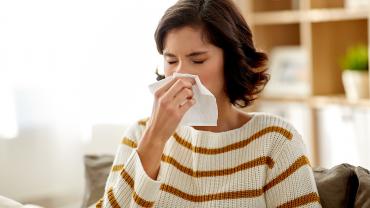
According to the Centers for Disease Control and Prevention, nearly 60 million Americans suffer from allergic rhinitis. Pollen, mold, and other common environmental and indoor allergens, such as dust and pet dander trigger a release of pro-inflammatory leukotrienes and prostanoids in the mucous membranes, and these activate an army of mast cells (MCs) and eosinophils. These white blood cells begin to degranulate and release pro-inflammatory cytokines at the site of inflammation often causing common symptoms seen in allergic rhinitis, which include a runny and/or itchy nose, sneezing, watery eyes, congestion, fatigue, headache, and sometimes a mild fever. Aside from tree pollen and dust, can there be other potential triggers for increased allergic reactions?
According to an in vivo, cell culture study published this month in the International Journal of Molecular Sciences, increased allergic reactions may be associated with corticotropin-releasing hormone (CRH), the stress-mediating neurohormone that regulates the hypothalamic-pituitary-adrenal (HPA) axis. Researchers hypothesized that due to its role in inducing MC proliferation and degranulation in human skin, CRH release may play a key role in stress-aggravated nasal allergy.
In the study, researchers found that “CRH acts primarily as a potent human MC secretagogue, not only in human skin, but also in the upper airway mucosa.” The results showed that human nasal mucosal mast cells (hM-MCs) can proliferate within inflamed nasal mucosa and are exacerbated by increases in CRH. Furthermore, the data demonstrated that CRH can increase the diameter and expression of tryptase granules (a pro-inflammatory protease) in hM-MCs, suggesting that “psychoemotional stress may aggravate MC-dependent mucosal inflammation via CRH-induced tryptase secretion” and could be a clinical target for patients with seasonal and/or perennial allergies.
Clinical interventions that address dietary and lifestyle modifications and dietary supplementation can be made to help improve perceived stress levels and reduce overall inflammation. Adopting an anti-inflammatory diet, increasing low-intensity exercise, mind-body practices, and getting sufficient restorative sleep are fundamental to supporting healthy stress and inflammatory responses. Supplementation with B vitamins may support the stress response, as they are required cofactors for key enzymes involved in methylation and neurotransmitter synthesis, which are critical to supporting a healthy stress response. Gamma-aminobutyric acid (GABA) also serves as the primary calming agent for the body, as the brain’s major inhibitory neurotransmitter, helping to combat perceived stress and occasional anxiety. Ashwagandha, rhodiola, lemon balm, and chamomile are all herbal botanicals that have been shown to help lower cortisol levels naturally. In addition, natural therapies, such as vagal nerve stimulation, which decreases CRH, may help modulate the HPA axis.
Nettle leaf extract is known for its efficacy in helping to manage seasonal allergy symptoms, as it contains compounds with antagonistic effects against key receptors and enzymes involved in pro-inflammatory pathways, such as histamine-1 receptor, MC tryptase, cyclooxygenase (COX)-1, COX-2, and prostaglandin D(2) synthase, which prevent the degranulation and release of pro-inflammatory mediators that cause symptoms of hay fever. Quercetin is known to inhibit histamine release and MC degranulation. As a potent antioxidant, vitamin C aids in regulating histamine levels and controlling inflammatory responses.
By Caitlin Higgins, MS, LDN, CNS